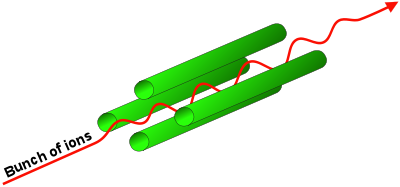Remember earlier how I said you can manipulate ion motion with electric fields? That& #39;s exactly how a quadrupole works! As you can probably guess from the name, this analyzer has four (quad) rods and the goal is for the ions to go from one side to the other.
This is possible because we apply voltages to each set of rods and that governs how ions of a certain size will travel through them.
So when I say "small ions", I mean ions with a small mass-to-charge ratio. Same if I say "large ions", I& #39;m still talking about the ratios. Cool?
So when I say "small ions", I mean ions with a small mass-to-charge ratio. Same if I say "large ions", I& #39;m still talking about the ratios. Cool?
I& #39;m also going to talk about one pair of rods at a time, before connecting the dots. Bare with me, I& #39;ll put a YouTube video at the end too!
I should also mention that we have two types of voltages we apply, a static one (that& #39;s call a direct current, DC) and one that switches from positive to negative (that& #39;s called radio frequency, RF).
Okay, so let& #39;s talk about a small positively charged ion going through the first pair of rods and what happens when we apply ONLY the static, DC voltage.
Like with magnets, similar charges repel each other, so a positively charged ion won& #39;t like being near positive rods
Like with magnets, similar charges repel each other, so a positively charged ion won& #39;t like being near positive rods
Meaning it& #39;ll try it& #39;s best to stay in the middle of them. Once you apply the RF voltage, we have a different story.
Let& #39;s set the stage. The RF voltage switches from positive to negative charges and the small ion can feel that and it changes direction, like this https://abs.twimg.com/emoji/v2/... draggable="false" alt="👇" title="Rückhand Zeigefinger nach unten" aria-label="Emoji: Rückhand Zeigefinger nach unten">
https://abs.twimg.com/emoji/v2/... draggable="false" alt="👇" title="Rückhand Zeigefinger nach unten" aria-label="Emoji: Rückhand Zeigefinger nach unten">
Let& #39;s set the stage. The RF voltage switches from positive to negative charges and the small ion can feel that and it changes direction, like this
But when the RF voltage switches, it pushes the small ion towards the rod and we lose it! Once it& #39;s gone, it& #39;s gone forever and it doesn& #39;t make it to the end of our story.
THERE& #39;S HOPE! If we have a large ion, it can& #39;t get pushed around so much by the RF voltage and those make it through to the finish line!
Everyone still okay?
On to pair #2 then! Since you know what happens with positive rods, the negative rods are the opposite!
Like magnets, opposites attract! So large, positively charged ions, are immediately attracted to them, hit them, and are lost forever.
Like magnets, opposites attract! So large, positively charged ions, are immediately attracted to them, hit them, and are lost forever.
In THIS scenario, our small ions have their time to shine! Since their motion changes dramatically with the RF voltages, they move in a wave motion and make it to the end! They never hit the rods, they just get close, before changing direction again.
When you have BOTH sets of rods together, you can tune their voltages to only let the ions you want make it to the end. That& #39;s what makes these analyzers so cool. They& #39;re tunable! You keep what you want and can get rid of what you don& #39;t want!
Pretty cool, right?!

 Read on Twitter
Read on Twitter


